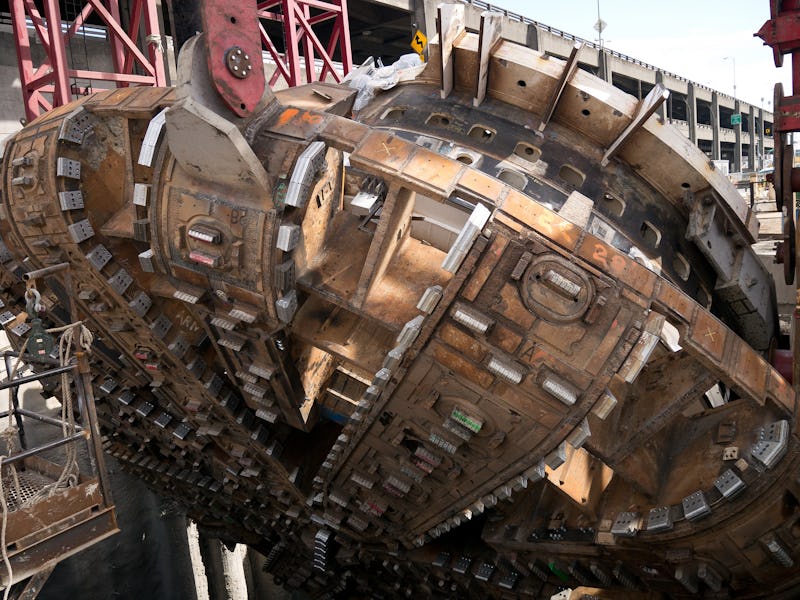Elon Musk hates traffic — so much so that he has a grand plan to start a “boring” company and dig a tunnel under Los Angeles to fix it. But some observers pointed out that the Washington State Department of Transportation already has a giant boring machine, named Bertha, only don’t confuse her real work to Musk’s hypothetical plans. Bertha’s almost finished with her project, a tunnel meant to replace an aging viaduct in Seattle, and Musk’s vastly different project has yet to break ground.
“Aside from the fact that we’re boring, and there are certainly other projects in the world using bored tunnel machines, I don’t see the similarities,” Alaskan Way Viaduct Replacement Program media relations manager Laura Newborn tells Inverse. “This is being done for the purpose of replacing an aging highway, which is different from what Elon Musk is saying, which is ‘let’s improve traffic’ [using boring machines].”
Bertha’s first job was to build a two-mile-long tunnel beneath Seattle to replace the Alaskan Way Viaduct damaged by the Nisqually earthquake in 2001. WSDOT announced last Friday that the bore only has to clear 2,600 more feet to complete “her” task. She’s expected to finish in June 2017 — roughly four years after breaking ground in July 2013 — and Newborn says the project itself will finish in “several years.”
Musk’s concept is simple in theory: roads are too crowded, and the inability to move buildings out of the way or perfect flying cars on a reasonable timeline leaves burrowing into the ground as the most viable option for expanding available roadways. Work on the Alaskan Way Viaduct is being done to replace old infrastructure; Musk’s tunnels would address the less concrete problem of having to sit in traffic for ungodly periods of time.
Musk has brought up the idea of boring tunnels to fix traffic problems a few times. The first was in January at the Hyperloop Design Competition at Texas A&M. He said:
It’s not that hard, but if you have tunnels in cities, it would massively alleviate congestion. You could have tunnels at all different levels, you could have 30 layers of tunnels and completely relieve the congestion problem in high-density cities. So, I highly suggest tunnels.
He reiterated his fondness of tunnels on Saturday with a series of tweets about how he was going to found “The Boring Company” with the tagline “Boring, it’s what we do” after complaining about once again being stuck in the notoriously bad traffic of Los Angeles. (Musk could be poking fun at himself here — his energy startup is called Tesla and his space company is dubbed SpaceX.)
Boring machines like Bertha could be the only way to get Musk’s ambitious plan done. It’s easier to use giant bores in cities instead of the cut-and-clear method that requires cities to “cut a box out of the ground and cover it, which you can’t do when you have millions of pounds of buildings above you,” Newborn says. “The advancement of boring machines, of which there are many different kinds, has really allowed cities to take a step forward.” That’s also because they allow roads above them to stay open.
Besides annoying Silicon Valley’s tech mogul, traffic can take a toll on people. A study found that sitting in traffic makes people aggressive, fat, antisocial, and at risk of developing heart problems from exposure to pollutants, among other things.
That’s part of why cities around the United States are trying to use technology to reduce traffic, whether it’s via autonomous vehicles, better public transit, or with vehicle-to-vehicle communications tools. All of these technological advancements would allow these cities to remove “shitty commute” from their list of downfalls.
But why not just dig a hole? The machines are sophisticated enough to allow this to happen, they let roads above stay open, and they’re pretty cool.
But don’t expect Bertha to be working on any ambitious traffic improvements just yet. Her current mission is just keeping up the status quo. “This is not designed to improve traffic. It’s a replacement program,” Newborn tells Inverse. “It was designed to replace an aging viaduct with a bypass to Seattle to get you through the city.” Bertha isn’t digging Musk’s tunnels before he gets a chance to do so; she’s just a boring worker on an old viaduct.
